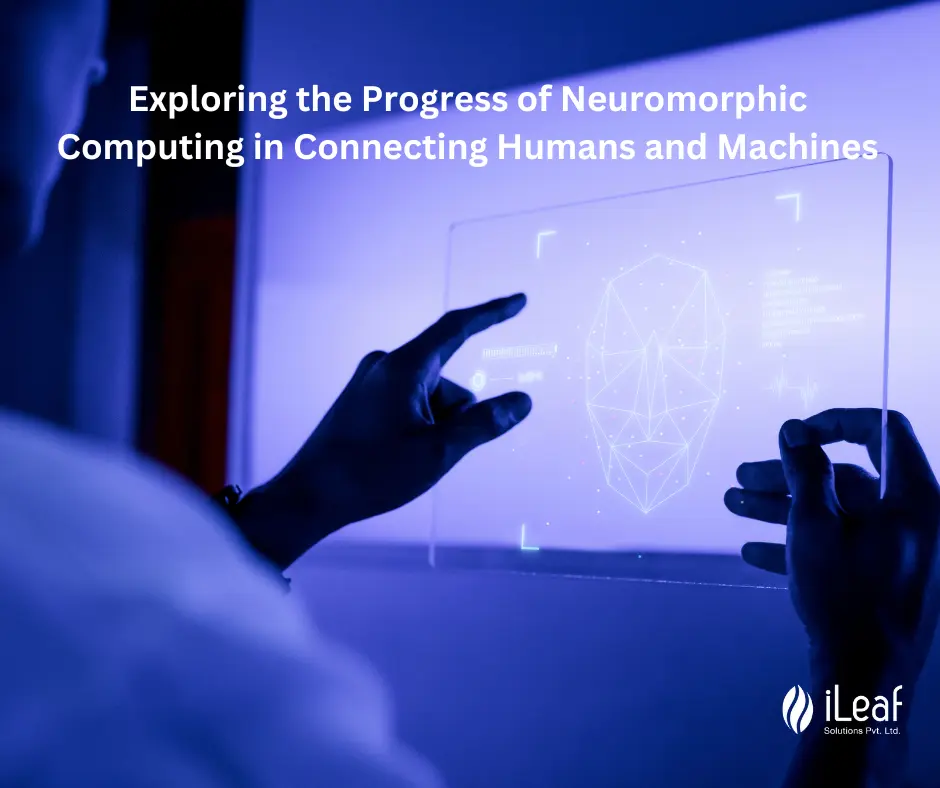Bridging the Gap Between Humans and Machines: Understanding the Advancements in Neuromorphic Computing

In an era where technology is advancing at an unprecedented pace, the quest to bridge the gap between humans and machines has become increasingly fascinating.Enter neuromorphic computing – a cutting-edge field that holds the promise of revolutionizing the way we interact with technology. With its ability to mimic the intricate workings of the human brain, neuromorphic computing aims to bring us closer to creating intelligent machines that can think, reason, and learn just like humans. This groundbreaking technology has the potential to transform various industries, from healthcare and robotics to finance and transportation. Join us as we delve into the world of neuromorphic computing, exploring the latest advancements, applications, and the impact it may have on our future. Get ready to unlock the secrets behind this remarkable field and discover how it is shaping the course of human-machine interaction.
What is neuromorphic computing?
Neuromorphic computing aims to create computer systems that mimic the structure and functions of the human brain, making it an emerging field.Unlike traditional computing, which relies on sequential processing and binary logic, neuromorphic computing leverages the parallel processing capabilities and neural network architectures to create intelligent systems. The term "neuromorphic" refers to the resemblance of these systems to the human brain's neural networks.Neuromorphic computing systems are built using specialized hardware and software architectures that can simulate the behavior of biological neurons and synapses. These systems enable the processing of vast amounts of data in parallel, allowing for faster and more efficient computations. By replicating the brain's neural connections and synaptic plasticity, neuromorphic computing aims to achieve highly efficient and adaptable computing systems.Neuromorphic computing has the potential to unlock new horizons in artificial intelligence (AI) and machine learning (ML) by enabling machines to process and understand information in a way that closely resembles human cognition. With its potential to transform multiple industries, such as healthcare, robotics, finance, and transportation, neuromorphic computing has the capacity to bring about a revolutionary change.
Advantages of neuromorphic computing.
A notable advantage of neuromorphic computing is its capability to efficiently process information in a parallel manner, while consuming minimal energy. Traditional computing architectures, such as the von Neumann architecture, rely on sequential processing, which can lead to bottlenecks and inefficiencies when dealing with complex data sets. In contrast, neuromorphic computing systems can handle massive amounts of data simultaneously, allowing for faster and more efficient computations.Another advantage of neuromorphic computing is its ability to learn and adapt in real-time. Inspired by the brain's plasticity, neuromorphic systems can modify their connection strengths and neural pathways based on experience. This capability enables the development of intelligent machines that can learn from their environment, make predictions, and adapt to new situations.Furthermore, neuromorphic computing holds the potential to reduce the energy consumption of computing systems significantly. The brain is incredibly energy-efficient, consuming only a fraction of the power compared to traditional computers. By mimicking the brain's neural architecture, neuromorphic computing systems can achieve similar levels of energy efficiency, leading to reduced power consumption and lower operating costs.Overall, the advantages of neuromorphic computing make it a highly promising field with the potential to revolutionize the way we process information and interact with machines.
Neuromorphic computing vs traditional computing.
Neuromorphic computing differs significantly from traditional computing in terms of architecture, functionality, and computational paradigms. While traditional computing relies on sequential processing and binary logic, neuromorphic computing leverages parallel processing and neural network architectures inspired by the human brain.Traditional computing systems, based on the von Neumann architecture, consist of a central processing unit (CPU), memory, and input/output devices. These systems execute instructions in a sequential manner, one after the other, performing calculations and manipulating data according to predefined algorithms. While traditional computers excel at arithmetic calculations and logical operations, they struggle with tasks that require pattern recognition, data interpretation, and learning.On the other hand, neuromorphic computing systems are designed to mimic the brain's neural networks and synaptic connections. These systems comprise specialized hardware and software that can simulate the behavior of biological neurons and synapses. By leveraging parallel processing and neural network architectures, neuromorphic computing enables machines to process information in a way that closely resembles human cognition.Neuromorphic computing systems excel at tasks such as pattern recognition, image processing, natural language processing, and machine learning. Unlike traditional computing, which requires explicit instructions and predefined algorithms, neuromorphic computing systems can learn from experience and adapt their behavior based on the data they receive. This ability to learn and adapt in real-time makes neuromorphic computing particularly suited for applications that require complex data analysis and decision-making.In summary, while traditional computing is well-suited for arithmetic calculations and logical operations, neuromorphic computing excels at tasks that involve pattern recognition, learning, and adaptive behavior.
Applications of neuromorphic computing
The potential applications of neuromorphic computing are vast and span across various industries. Let's explore some of the exciting areas where this groundbreaking technology is making a significant impact.
* Healthcare
In the field of healthcare, neuromorphic computing has the potential to revolutionize medical diagnostics, drug discovery, and personalized medicine. By analyzing vast amounts of patient data, such as medical records, genetic information, and imaging data, neuromorphic systems can help identify patterns, detect anomalies, and provide accurate diagnoses. Additionally, the ability of neuromorphic systems to learn and adapt makes them ideal for developing personalized treatment plans based on individual patient profiles.Neuromorphic computing can also play a crucial role in prosthetics and assistive technologies. By interfacing with the human nervous system, neuromorphic systems can enable more natural and intuitive control of prosthetic limbs, enhancing the quality of life for individuals with limb loss or disabilities. Furthermore, neuromorphic systems can help restore sensory perception by bridging the gap between human nerves and artificial sensors.
* Robotics
In the field of robotics, neuromorphic computing can enable the development of intelligent and autonomous robots capable of interacting with their environment and adapting to changing circumstances. Traditional robots often rely on pre-programmed instructions and lack the ability to learn and adapt in real-time. Neuromorphic systems can change that by allowing robots to process sensory information, recognize objects, and learn from their interactions with the environment.Neuromorphic computing can also enhance the safety and efficiency of autonomous vehicles. By leveraging neuromorphic systems, self-driving cars can better interpret sensor data, make real-time decisions, and adapt to unpredictable road conditions. This technology has the potential to revolutionize transportation systems, making them safer, more efficient, and environmentally friendly.
* Finance
In the field of finance, neuromorphic computing can improve risk assessment, fraud detection, and financial forecasting. By analyzing vast amounts of financial data, such as market trends, customer behavior, and transaction patterns, neuromorphic systems can identify complex patterns and anomalies that traditional methods might miss. This capability can help financial institutions make more informed decisions, mitigate risks, and detect fraudulent activities.Neuromorphic computing can also enhance algorithmic trading by providing more accurate predictions and faster processing of market data. By leveraging the brain-inspired parallel processing capabilities, neuromorphic systems can analyze large volumes of data in real-time, enabling traders to make better-informed decisions and react quickly to market changes.
* Transportation
In the field of transportation, neuromorphic computing can play a crucial role in optimizing traffic flow, reducing congestion, and enhancing safety. By analyzing real-time data from various sources, such as traffic cameras, sensors, and GPS devices, neuromorphic systems can identify traffic patterns, predict congestion, and optimize traffic signal timings. This technology can help reduce travel times, minimize fuel consumption, and improve overall traffic management.Neuromorphic computing can also enhance the safety of autonomous vehicles by enabling real-time decision-making based on sensor data. By mimicking the brain's ability to process sensory information and make split-second decisions, neuromorphic systems can help autonomous vehicles navigate complex and dynamic environments.
Challenges and limitations of neuromorphic computing
While neuromorphic computing shows great promise, it also faces several challenges and limitations that need to be addressed. Let's explore some of the key hurdles associated with this groundbreaking technology.
* Hardware complexity and scalability
Building neuromorphic computing systems with the level of complexity and scale required to mimic the human brain is a significant challenge. The brain consists of billions of interconnected neurons and synapses, each performing complex computations simultaneously. Replicating this level of complexity in hardware is a daunting task that requires advancements in material science, nanotechnology, and fabrication techniques.Furthermore, scaling neuromorphic computing systems to handle large-scale data sets and complex computations poses additional challenges. While current neuromorphic systems can simulate a fraction of the brain's computational capacity, achieving brain-level performance and scalability remains a formidable objective.
* Lack of standardized architectures and programming models
Another challenge in neuromorphic computing is the lack of standardized architectures and programming models. Unlike traditional computing, which relies on well-defined architectures and programming languages, neuromorphic computing is still in its infancy, with various research groups and companies developing their own proprietary systems.
The absence of standardized architectures and programming models hinders interoperability, collaboration, and widespread adoption of neuromorphic computing. Efforts are underway to develop common frameworks and programming languages that can facilitate the design and implementation of neuromorphic systems.
* Data acquisition and training
Neuromorphic systems rely on large amounts of labeled training data to learn and adapt.Acquiring and labeling such data can be a time-consuming and expensive process. Furthermore, the quality and diversity of the training data play a crucial role in the performance and generalization capabilities of neuromorphic systems.Additionally, the training process itself can be computationally intensive and time-consuming. Training neural networks with billions of parameters requires significant computational resources and efficient algorithms. Advancements in hardware and software optimization techniques are needed to accelerate the training process and make it more accessible.
* Ethical and privacy concerns
As with any disruptive technology, neuromorphic computing raises ethical and privacy concerns. The ability of neuromorphic systems to analyze vast amounts of data and make autonomous decisions raises questions about privacy, data security, and the potential for misuse.Ensuring ethical and responsible use of neuromorphic computing technology requires robust governance frameworks, transparency, and regulations. Balancing the benefits of neuromorphic computing with the protection of individual privacy and societal well-being is a crucial consideration moving forward.
Recent advancements in neuromorphic computing
Despite the challenges, neuromorphic computing has witnessed significant advancements in recent years. Let's explore some of the breakthroughs and innovations that have propelled this field forward.
* Hardware advancements
Advancements in hardware technology have played a crucial role in the development of neuromorphic computing systems. Specialized neuromorphic chips, such as IBM's TrueNorth and Intel's Loihi, have been designed to simulate the behavior of biological neurons and synapses efficiently. These chips leverage novel architectures and circuit designs to achieve high-performance neural network simulations.Furthermore, developments in nanotechnology and fabrication techniques have enabled the creation of complex neural circuits with unprecedented scale and density. Researchers are exploring novel materials, such as memristors and phase-change materials, that can mimic the synaptic behavior of biological systems.
* Software frameworks and tools
The availability of software frameworks and tools has facilitated the design, simulation, and implementation of neuromorphic systems. Frameworks such as NEST, SpiNNaker, and BrainScaleS provide researchers and developers with the necessary tools to model and simulate large-scale neural networks. These frameworks enable researchers to explore the behavior of neural circuits, optimize algorithms, and validate their designs.Additionally, advancements in machine learning algorithms, such as deep learning and reinforcement learning, have enhanced the capabilities of neuromorphic systems. These algorithms enable machines to learn from data, make predictions, and adapt their behavior based on feedback.
* Neuromorphic computing platforms
Several organizations and research institutions have developed neuromorphic computing platforms that provide researchers and developers with access to high-performance computing resources. Platforms such as the Human Brain Project and the Neuromorphic Computing Platform provide researchers with the necessary infrastructure to explore and experiment with neuromorphic systems.These platforms enable researchers to collaborate, share resources, and accelerate the development of neuromorphic computing technology. By fostering an open and collaborative environment, these platforms are driving innovation and pushing the boundaries of neuromorphic computing.
Let's wind up!
Neuromorphic computing has significant implications for the field of artificial intelligence (AI). By leveraging the brain-inspired parallel processing capabilities, neuromorphic systems can enhance the performance and efficiency of AI algorithms.Neuromorphic systems can accelerate machine learning algorithms, enabling faster training and inference times. The parallel processing capability and real-time adaptability of neuromorphic systems make them ideally suited for a range of tasks, including image and speech recognition, natural language processing, and robotics.Furthermore, neuromorphic computing can enhance the explainability and interpretability of AI systems. Traditional AI algorithms, such as deep neural networks, often operate as black boxes, making it challenging to understand and interpret their decision-making processes. Neuromorphic systems, on the other hand, can provide insights into the internal workings of the neural networks, enabling researchers to gain a deeper understanding of the AI algorithms and their outputs.














